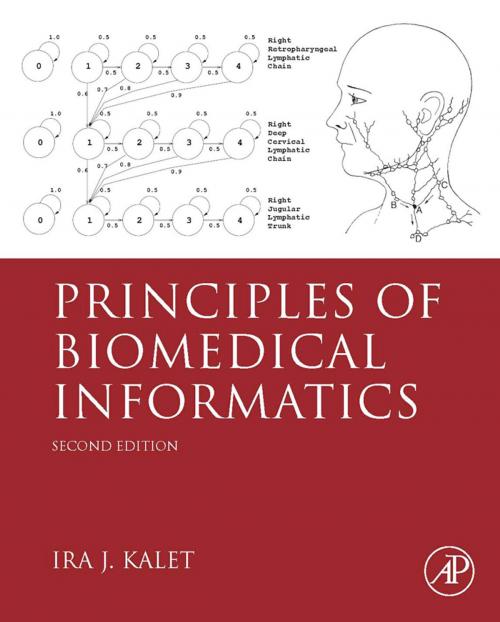Principles of Biomedical Informatics
Business & Finance, Management & Leadership, Operations Research, Nonfiction, Computers| Author: | Ira J. Kalet, PhD | ISBN: | 9780123914620 |
| Publisher: | Elsevier Science | Publication: | September 26, 2013 |
| Imprint: | Academic Press | Language: | English |
| Author: | Ira J. Kalet, PhD |
| ISBN: | 9780123914620 |
| Publisher: | Elsevier Science |
| Publication: | September 26, 2013 |
| Imprint: | Academic Press |
| Language: | English |
This second edition of a pioneering technical work in biomedical informatics provides a very readable treatment of the deep computational ideas at the foundation of the field. Principles of Biomedical Informatics, 2nd Edition is radically reorganized to make it especially useable as a textbook for courses that move beyond the standard introductory material. It includes exercises at the end of each chapter, ideas for student projects, and a number of new topics, such as: • tree structured data, interval trees, and time-oriented medical data and their use • On Line Application Processing (OLAP), an old database idea that is only recently coming of age and finding surprising importance in biomedical informatics • a discussion of nursing knowledge and an example of encoding nursing advice in a rule-based system • X-ray physics and algorithms for cross-sectional medical image reconstruction, recognizing that this area was one of the most central to the origin of biomedical computing • an introduction to Markov processes, and • an outline of the elements of a hospital IT security program, focusing on fundamental ideas rather than specifics of system vulnerabilities or specific technologies.
It is simultaneously a unified description of the core research concept areas of biomedical data and knowledge representation, biomedical information access, biomedical decision-making, and information and technology use in biomedical contexts, and a pre-eminent teaching reference for the growing number of healthcare and computing professionals embracing computation in health-related fields.
As in the first edition, it includes many worked example programs in Common LISP, the most powerful and accessible modern language for advanced biomedical concept representation and manipulation.
The text also includes humor, history, and anecdotal material to balance the mathematically and computationally intensive development in many of the topic areas. The emphasis, as in the first edition, is on ideas and methods that are likely to be of lasting value, not just the popular topics of the day. Ira Kalet is Professor Emeritus of Radiation Oncology, and of Biomedical Informatics and Medical Education, at the University of Washington. Until retiring in 2011 he was also an Adjunct Professor in Computer Science and Engineering, and Biological Structure. From 2005 to 2010 he served as IT Security Director for the University of Washington School of Medicine and its major teaching hospitals. He has been a member of the American Medical Informatics Association since 1990, and an elected Fellow of the American College of Medical Informatics since 2011. His research interests include simulation systems for design of radiation treatment for cancer, software development methodology, and artificial intelligence applications to medicine, particularly expert systems, ontologies and modeling.
- Develops principles and methods for representing biomedical data, using information in context and in decision making, and accessing information to assist the medical community in using data to its full potential
- Provides a series of principles for expressing biomedical data and ideas in a computable form to integrate biological, clinical, and public health applications
- Includes a discussion of user interfaces, interactive graphics, and knowledge resources and reference material on programming languages to provide medical informatics programmers with the technical tools to develop systems
This second edition of a pioneering technical work in biomedical informatics provides a very readable treatment of the deep computational ideas at the foundation of the field. Principles of Biomedical Informatics, 2nd Edition is radically reorganized to make it especially useable as a textbook for courses that move beyond the standard introductory material. It includes exercises at the end of each chapter, ideas for student projects, and a number of new topics, such as: • tree structured data, interval trees, and time-oriented medical data and their use • On Line Application Processing (OLAP), an old database idea that is only recently coming of age and finding surprising importance in biomedical informatics • a discussion of nursing knowledge and an example of encoding nursing advice in a rule-based system • X-ray physics and algorithms for cross-sectional medical image reconstruction, recognizing that this area was one of the most central to the origin of biomedical computing • an introduction to Markov processes, and • an outline of the elements of a hospital IT security program, focusing on fundamental ideas rather than specifics of system vulnerabilities or specific technologies.
It is simultaneously a unified description of the core research concept areas of biomedical data and knowledge representation, biomedical information access, biomedical decision-making, and information and technology use in biomedical contexts, and a pre-eminent teaching reference for the growing number of healthcare and computing professionals embracing computation in health-related fields.
As in the first edition, it includes many worked example programs in Common LISP, the most powerful and accessible modern language for advanced biomedical concept representation and manipulation.
The text also includes humor, history, and anecdotal material to balance the mathematically and computationally intensive development in many of the topic areas. The emphasis, as in the first edition, is on ideas and methods that are likely to be of lasting value, not just the popular topics of the day. Ira Kalet is Professor Emeritus of Radiation Oncology, and of Biomedical Informatics and Medical Education, at the University of Washington. Until retiring in 2011 he was also an Adjunct Professor in Computer Science and Engineering, and Biological Structure. From 2005 to 2010 he served as IT Security Director for the University of Washington School of Medicine and its major teaching hospitals. He has been a member of the American Medical Informatics Association since 1990, and an elected Fellow of the American College of Medical Informatics since 2011. His research interests include simulation systems for design of radiation treatment for cancer, software development methodology, and artificial intelligence applications to medicine, particularly expert systems, ontologies and modeling.
- Develops principles and methods for representing biomedical data, using information in context and in decision making, and accessing information to assist the medical community in using data to its full potential
- Provides a series of principles for expressing biomedical data and ideas in a computable form to integrate biological, clinical, and public health applications
- Includes a discussion of user interfaces, interactive graphics, and knowledge resources and reference material on programming languages to provide medical informatics programmers with the technical tools to develop systems















